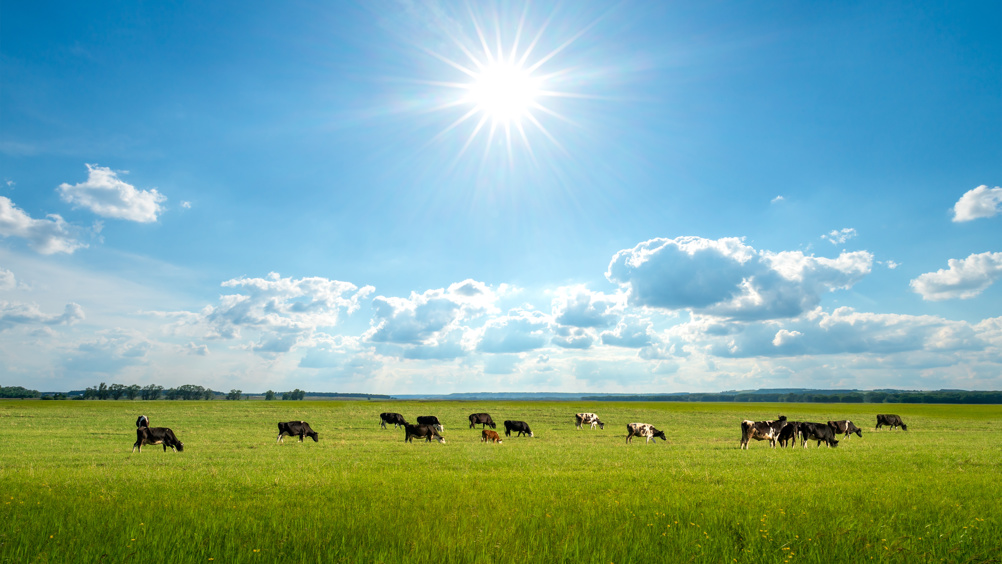Methane emissions
Pasture-based dairy systems are under increasing pressure to reduce their greenhouse gas emissions. Ireland and New Zealand are two countries operating predominantly pasture-based dairy production systems where enteric methane (CH4) contributes 23% and 36% of total national emissions, respectively. Ireland currently has a national commitment to reduce 51% of total greenhouse gas emissions and 25% from agriculture by 2030. New Zealand's national commitment is to reduce CH4 emissions by 10% by 2030 and between 24–47% by 2050. To achieve these reductions, factors that affect enteric CH4 production in a pasture-based system need to be investigated. The objective of a study by Starsmore et al (2024) (Journal of Dairy Science 10.3168/jds.2023-23915) was to assess the relationship between enteric CH4 and other animal traits (feed intake, metabolic liveweight, energy corrected milk yield, milk urea concentration, and body condition score) in a grazing dairy system. Enteric CH4 emissions were measured on 45 late lactation grazing Holstein-Friesian (HF) and HF×Jersey crossbred cows using GreenFeed monitoring equipment for 10 weeks. The average enteric CH4 produced in the study was 352 g +/- 45.7 g per day with an animal-to-animal coefficient of variation of 13%. A multiple linear regression model indicated that each unit increase in energy corrected milk yield, metabolic liveweight and milk urea concentration, resulted in an increase in enteric CH4 production per day by 3.9, 1.74 and 1.38 g, respectively. Although each one unit increase in body condition score resulted in a decrease in 39.03 g CH4 produced per day. When combined, these factors explained 47% of the variation in CH4 production, indicating that there is a large proportion of variation not included in the model. The repeatability of the CH4 measurements was 0.66, indicating that cows are relatively consistently exhibiting the same level of CH4 throughout the study. Therefore, enteric CH4 production is suitable for phenotyping.
Heat stress
As we move into the summer months, the temperature is set to rise again, perhaps to record levels. Heat stress compromises dairy production by decreasing feed intake and milk yield, and it may also alter milk composition and feed efficiency. However, little information is available for evaluating such effects across different levels of heat stress and cows enrolled in heat stress studies. The objectives of a study by Chen et al (2024) (Journal of Dairy Science 10.3168/jds.2023-24059) were to evaluate the effects of heat stress on dry matter intake (DMI), energy-corrected milk (ECM), milk composition and feed efficiency (kg ECM/kg DMI) and to investigate the relationship between such effects and heat stress intervention and animal characteristics by using meta-analytical approaches. Data from 31 studies (34 trials) fulfilled the inclusion criteria and were used for analysis. Results showed that heat stress decreased DMI, ECM and milk protein concentration, but did not alter milk fat concentration or feed efficiency. Meta-regression confirmed that such reductions in DMI and ECM were significantly associated with increasing temperature-humidity index. Over the period of heat stress, for each unit increase in temperature–humidity index, DMI and ECM decreased by 4.13% and 3.25%, respectively, in mid-lactation cows. Regression models further revealed the existence of a strong interaction between temperature–humidity index and lactation stage, which partially explained the large heterogeneity in effect sizes of DMI and ECM. The results indicated a need for more research on the relationship between the effect of heat stress and animal characteristics. This study calls for the implementation of mitigation strategies in heat-stressed herds due to the substantial decrease in productivity.
Schistosoma reflexum
Schistosoma reflexum (SR) is a lethal congenital syndrome characterized by U-shaped dorsal retroflexion of the spine and exposure of abdominal viscera, that most of us have occasionally encountered associated with dystocia. The syndrome was thought to be inherited as a Mendelian trait. However, a study by Jacinto et al (2024) (10.1016/j.tvjl.2024.106069) collected a series of 23 schistosoma reflexum-affected calves from four breeds (20 Holstein, one Red Danish, one Limousin, one Romagnola) and performed wholegenome sequencing. Whole-genome sequencing was performed on 51 cattle, including 14 cases with parents (trio-based; Group 1) and nine single cases (solo-based; Group 2). Sequencing-based genome-wide association studies with 20 Holstein cases and 154 controls showed no association. Assuming a monogenic recessive inheritance, no region of shared homozygosity was observed, suggesting heterogeneity. Alternatively, the presence of possible dominant acting de novo mutations were assessed. In Group 1, heterozygous private variants, absent in both parents, were found in seven cases. In addition, heterozygous private variants affecting five genes were identified in five cases from Group 2. The detected frameshift and missense variants are predicted to cause haploinsufficiency. Each of these 12 affected genes belong to the class of haploinsufficient loss-of-function genes or are involved in embryonic and pre-weaning lethality or are known to be associated with severe malformation syndromes in humans and/or mice. This study presents, for the first time, a detailed genomic evaluation of bovine schistosoma reflexum, suggesting that independent de novo mutations may explain the sporadic occurrence of schistosoma reflexum in cattle. If confirmed, this will have implications for the advice we might give about rebreeding animals that produce schistosoma reflexum calves.


